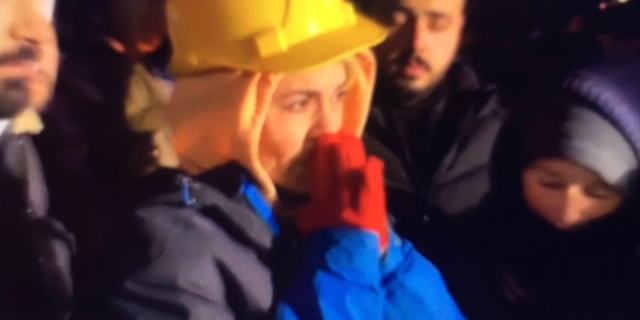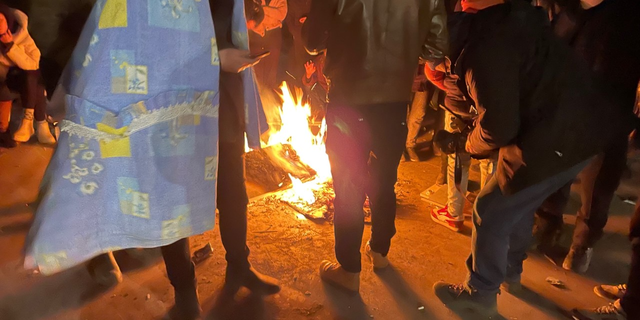ISKENDERUN, Turkey – It hung in the air of the streets of the Turkish city of Iskenderun Monday. The smell of death. One week after twin earthquakes rocked the region, dramatic rescues were getting infrequent and instead replaced by a grim recovery of bodies crushed under the rubble of the quake’s horrific force. The hard-hit city was swarming with emergency teams busy at work with heavy construction machinery at many sites.
The ritual is bone-chilling. At one location we were at, the digging machine would be at work, and a body would be found. The call goes out for family to identify it. Howls of horror and sorrow are next. The victim carried off in a body bag to be placed in wooden casket and driven off in a van from the morgue. We saw this happen several times.
The aftermath of the huge earthquakes have taken several turns since we first arrived in Turkey last week. Our first stop Tuesday was Kahramanmaras, the town closest to the epicenter of the first major quake. After a deceptively calm drive through its mainly untouched outskirts, the full force of the natural disaster became apparent with building after building folded in onto themselves
Kahramanmaras is the Turkish town closest to the epicenter of the first major quake. So far, some 35,000 deaths have been reported from the quakes that hit Turkey and Syria. (Greg Palkot/Fox News)
TURKEY-SYRIA EARTHQUAKE DEATH TOLL LIKELY TO SURPASS 56,000, UN EMERGENCY AID CHIEF SAYS
Our live position that night was nearby a gas station; a beacon of life for the freshly bruised victims, who lined up for gas for their home generators with the power in the city gone, getting a charge for their phones on the station’s electricity and a quick warm-up.
As a follow-up to the disaster, the region was hit with snow and wind-whipped sub-freezing temperatures. Villagers huddled around fires to keep warm.
The next day, we were in Gazientep, the biggest city close to the quake. Usually bustling, this day was eerily silent. Some buildings had been knocked down. Most had been damaged. Forcing just about all the residents to stay out of their homes and keep shops and businesses closed.

A mother looks on as her son is rescued from the rubble in Gazientep. (Greg Palkot/Fox News)
The search for survivors at the site we covered was especially poignant. Waiting outside among many was the mother of a 17-year-old boy trapped in the wreckage. She had made it out alive. She spoke with us and prayed for him to survive. Two days later, her prayers were answered. Rescuers brought him out looking and sounding in great shape. His mother swore she would never let him leave her side.
TURKEY-SYRIA EARTHQUAKE: 5 FAMILY MEMBERS PULLED FROM RUBBLE AFTER 129 HOURS AS DEATH TOLL TOPS 25K

Gazientep, the biggest city closest to the earthquake. (Greg Palkot/Fox News)
On Thursday, we traveled to the mountain city of Adiyaman. Search and rescue teams from the Fairfax, Virginia, and Los Angeles Fire Departments had been brought there by USAID to lend a hand. It was much needed. The place was probably the worst-served by a struggling Turkish government we had seen. Everybody was getting into the act trying to find anyone alive while slipping on loose stones, carrying away rubble with bare hands, praying and cheering at any sign of life.
We were actually pressed into the mission, giving a team from L.A., all their gear, and a sniffer dog, Diva, a lift in our 18-seat van. After a torturous three-hour drive through streets that looked like Berlin after the war, we arrived at a caved-in structure. Another team thought there was life there. A circular blade saw was used to carve out a passageway through concrete. Camera and sensors were dropped in. But after a few sniffs around, sadly, Diva the dog quickly decided there was no hope.
As recovery efforts continued, the humanitarian crisis mounted. On Saturday, we went to a tent city set up by the Turkish military to accommodate the quake’s homeless in the city of Sanliurfa along with those just afraid to stay in their damaged homes amid all the aftershocks. We spoke with one 17-year-old girl who explained to us in perfect English that she was asleep in her family’s apartment on the 6th floor of a building when the quake hit. The apartment dropped two floors trapping her and her family inside. She was lucky. She was rescued six hours later along with the rest of her family. With barely a scratch. This night she had a smile for us.
US, UN EARTHQUAKE AID SLOW TO ENTER SYRIA AS BORDER ENTRY BARRIERS COMPOUNDS THE CRISIS
Turkish President Recep Tayyip Erdogan happened to be touring the place that day. We told him what critics had been saying, that his government had not prepared enough and was not doing enough to help quake victims. He tartly replied through his translator, “Of course there are deaths, it’s an earthquake.” We pressed him on whether his government could have done more, to which he replied, “We’re trying to solve the problems.” After, he walked off with his entourage.
One problem that emerged Sunday was perhaps at least some of this carnage could have been avoided if contractors had followed earthquake-safe zoning rules. Over 100 builders were cited by Turkish government officials as suspects. We were at one site in Adana, a big city on the west side of the quake zone, where a 14-story apartment building had completely collapsed while other buildings were still standing. Relatives of those killed stared at the debris, looking at material that did not seem to make the grade, including one man whose brother and family was killed. “I’m angry,” he told us, “but that doesn’t matter. They’re dead.”

President Recep Tayyip Erdogan is facing criticism over the lack of earthquake preparedness by his government. (Greg Palkot/Fox New)
Which brings us to Iskenderun and this day’s scene of death and destruction. As the natural disaster turned in to a humanitarian catastrophe. We visited an emergency clinic that had been set up across from the city’s main hospital too damaged by the quakes to handle patients. After the first wave of direct injuries from the quakes, like broken arms and legs, now they were handling a new wave of harm. Injuries from after-shocks. Near suffocation from inhaling dust and grit. “It’s bad,” one patient told us, “but we’re strong.”
That clinic was beefed up by a big presence of Indian aid, doctors and security. Part of the global outpouring of help that is helping Turkey cope. But sadly, just across a nearby border, in northern Syria, also affected by the quake, the landscape lies in ruins. An international community that the war-torn country has kept at a distance, providing little in the way of help, the people there struggling.
CLICK HERE TO GET THE FOX NEWS APP
I have covered many natural disasters around the world for Fox News. This ranks up there as one of the worst. My personal take-aways? First, how brave, caring and kind the Turkish people are, to each other, even to us outsiders, as they stood in the face of devastation. Second, how there needs to be a serious examination of what Ankara did or did not do, which contributed to these horrors. Finally, no matter how sophisticated and technologically in control we think we are, the forces around us, our natural world, will always have the last say.
Pray for the people of Turkey and Syria.